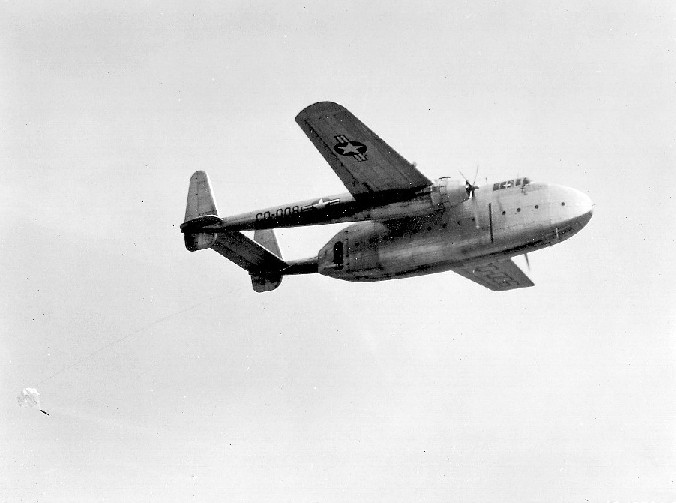- C-82 Packet
Infobox Aircraft
name = C-82 Packet
caption =
type = Cargo and troop transport
national origin =United States
manufacturer =Fairchild Aircraft
designer =
first flight = 1944
introduced =
retired =
status =
primary user =United States Army Air Force
more users =
produced =
number built = 223
unit cost =
developed from =
variants with their own articles =C-119 Flying Boxcar The C-82 Packet was a twin-engine,
twin-boom cargoaircraft designed and built byFairchild Aircraft . It was used briefly by theUnited States Army Air Forces andUnited States Navy followingWorld War II .Design and development
Developed by Fairchild, the C-82 was designed as a heavy-lift cargo aircraft to succeed pre-war designs like the Curtiss
C-46 Commando and DouglasC-47 Dakota . The aircraft was designed for a number of roles, including cargo carrier, troop transport, ambulance airplane and glider tow. The single prototype first flew on September 10, 1944. The aircraft were built at the Fairchild factory inHagerstown, Maryland , with deliveries beginning in late 1945 and ending in Septmber 1948Problems surfaced almost immediately as the aircraft was found to be underpowered and its airframe inadequate for the heavy lifting it was designed to perform. As a result the Air Force turned to Fairchild for a solution to the C-82's shortcomings. A redesign was quickly performed under the designation XC-82B, which would overcome all of the C-82A's initial problems. First flown in 1947, the XC-82B would go into production as the C-119B Flying Boxcar. In the end only 223 C-82A would be built, a very small number for a production cargo aircraft. Most were used for cargo and troop transport, although a few were used for paratroop operations or towing
glider s. During its brief operational life several C-82 Packets were utilized during the Berlin Airlift, primarily bringing assembled vehicles into the city.Though itself unsuccessful, the C-82A is best considered as an early development stage of the C-119B Flying Boxcar which saw limited production.
Fifty three C-82A were procured by the
United States Navy , though they too were quickly replaced by the Navy version of the C-119B Flying Boxcar.urvivors
*The last flyable C-82A had been owned and operated by
Hawkins & Powers Aviation , anaerial firefighting company located inGreybull, Wyoming . This plane was purchased at auction by the Hagerstown Aviation Museum in Hagerstown, Maryland. The aircraft was flown to theHagerstown Regional Airport onOctober 15 ,2006 . [ [http://www.hagerstownaviationmuseum.org/c82auctionupdate.html/ Hagarstown Aviation Museum coverage of the last flying C-82] ] This marks the last flight of a C-82. The plane will remain on display at the HRA until a dedicated space for it is made available in a future museum building to be built near the original Fairchild Manufacturing Facility. The fate of two additional incomplete C-82A (civil registration N5102B and N8009E) at the Greybull site is uncertain.Aircraft on display
* C-82A serial number "48-0581" is at the
National Museum of the United States Air Force nearDayton, Ohio . This aircraft is currently undergoing an extensive restoration of its fabric control surfaces and has been moved near the Museum's restoration facility.Fact|date=September 2008
* C-82A serial number "48-0574" is on display at the McChord Air Museum inTacoma, Washington
* C-82A serial number "44-22991" is in the Walter Soplata Collection inNewbury, Ohio . The aircraft is incomplete and stored outside.
* C-82A serial number "44-23006" is on display at thePima Air & Space Museum inTucson, Arizona
* C-82A civil registration "N6887C" is located in a playground inHermosillo, Mexico
* C-82A civil registration "PP-CEL" is located inManaus, Brazil . The aircraft is in poor condition.
* C-82A civil registration "2202" is stored at Campos dos Afonsos, Rio de Janeiro, Brazil. It is an ex Brazilian Air Force aircraft.
* C-82A civil registration "HK-426" is located at Bogota El Dorado Airport inBogotá, Colombia . The aircraft is incomplete and in very poor condition.pecifications (C-82A)
aircraft specifications
plane or copter?=plane
jet or prop?=prop
ref=
crew=three
capacity=42 paratroops or 34 stretchers
payload main=
payload alt=
length main= 77 ft 1 in
length alt= 23.50 m
span main= 106 ft 6 in
span alt= 32.47 m
height main= 26 ft 4 in
height alt= 8.03 m
area main= 1,400 ft²
area alt= 130.9 m²
airfoil=
empty weight main= 16,530 lb
empty weight alt= 12,045 kg
loaded weight main=
loaded weight alt=
useful load main= 42,000 lb
useful load alt= 19,050 kg
max takeoff weight main= 54,000 lb
max takeoff weight alt= 24,545 kg
more general=
engine (prop)=Pratt & Whitney R-2800 -85
type of prop=radials
number of props=2
power main= 2,100 hp
power alt= 1,567 kW
power original=
max speed main=250 mph
max speed alt= 400 km/h
cruise speed main=
cruise speed alt=
stall speed main=
stall speed alt=
never exceed speed main=
never exceed speed alt=
range main= 2,140 miles
range alt=3,424 km
ceiling main= 27,000 ft
ceiling alt= 8,232 m
climb rate main= 1,600 ft/min
climb rate alt= 488 m/min
loading main=30 lb/ft²
loading alt=146 kg/m²
thrust/weight=
power/mass main=0.10 hp/lb
power/mass alt=0.16 kW/kg
more performance=
armament=
avionics=Popular culture
The C-82 is perhaps best known for its role in the 1964 novel, "
The Flight of the Phoenix ", andRobert Aldrich 's original 1965 film version. Based on the novel byElleston Trevor , the story centers around a C-82 that crashes in a desert, is rebuilt using one tail boom, and flown to safety. ThreeFairchild C-82s (one flying and two derelict) were based atLong Beach Airport inCalifornia during the filming.Fact|date=September 2008 They were operated by Steward-Davis Inc. The flying aircraft was N6887C while the two derelicts were N4833V and N53228. The other aircraft used was an R4Q-1 Navy Packet BuNo.126580.ee also
aircontent
related=
*C-119 Flying Boxcar
*XC-120 Packplane
similar aircraft=
*C-123 Provider
lists=
see also=References
Wikimedia Foundation. 2010.
